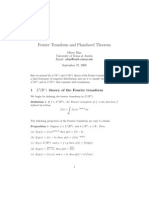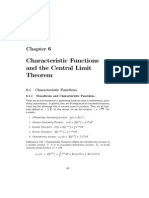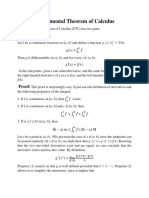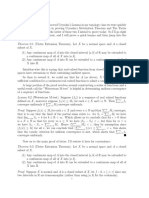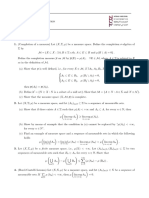Introduction To Some Convergence Theorems: 2.1 Recap
Uploaded by
Ashoka VanjareIntroduction To Some Convergence Theorems: 2.1 Recap
Uploaded by
Ashoka VanjareLecture 2
Introduction to Some Convergence theorems
Friday 14, 2005
Lecturer: Nati Linial
Notes: Mukund Narasimhan and Chris R e
2.1 Recap
Recall that for f : T C, we had dened
f(r) =
1
2
_
T
f(t)e
irt
dt
and we were trying to reconstruct f from
f. The classical theory tries to determine if/when the following is
true (for an appropriate denition of equality).
f(t)
??
=
rZ
f(r)e
irt
In the last lecture, we proved Fej ers theorem f k
n
f where the denotes convolution and k
n
(Fej er
kernels) are trignometric polynomials that satisfy
1. k
n
0
2.
_
T
k
n
= 1
3. k
n
(s) 0 uniformly as n outside [, ] for any > 0.
If X is a nite abelian group, then the space of all functions f : X Cforms an algebra with the operations
(+, ) where + is the usual pointwise sum and is convolution. If instead of a nite abelian group, we take
X to be T then there is no unit in this algebra (i.e., no element h with the property that h f = f for all f).
However the k
n
behave as approximate units and play an important role in this theory. If we let
S
n
(f, t) =
n
r=n
f(r)e
irt
Then S
n
(f, t) = f D
n
, where D
n
is the Dirichlet kernel that is given by
D
n
(x) =
sin
_
n +
1
2
_
s
sin
s
2
The Dirichlet kernel does not have all the nice properties of the the Fej er kernel. In particular,
8
1. D
n
changes sign.
2. D
n
does not converge uniformly to 0 outside arbitrarily small [, ] intervals.
Remark. The choice of an appropriate kernel can simplify applications and proofs tremendously.
2.2 The Classical Theory
Let G be a locally compact abelian group.
Denition 2.1. A character on G is a homomorphism : G T. Namely a mapping satisfyin (g
1
+g
2
) =
(g
1
)(g
2
) for all g
1
, g
2
G.
If
1
,
2
are any two characters of G, then it is easily veried that
1
2
is also a character of G, and so
the set of characters of G forms a commutative group under multiplication. An important role is played by
G, the group of all continuous characters. For example,
T = Z and
R = R.
For any function f : G C, associate with it a function
f :
G C where
f() = f, ). For
example, if G = T then
r
(t) = e
irt
for r Z. Then we have
f(
r
) =
f(r). We call
f :
G C the
Fourier transform of f. Now
G is also a locally compact abelian group and we can play the same game
backwards to construct
f. Pontryagins theorem asserts that
G = G and so we can ask the question: Does
f = f ? While in theory Fej er answered the question of when
f uniquely determines f, this question is still
left unanswered.
For the general theory, we will also require a normalized nonnegative measure on G that is translation
invariant: (S) = (a + S) = (a + s [s S) for every S G and a G. There exists a unique such
measure which is called the Haar measure.
2.3 L
p
spaces
Denition 2.2. If (X, , ) is a measure space, then L
p
(X, , ) is the space of all measureable functions
f : X R such that
|f|
p
=
__
X
[f[
p
d
_1
p
<
For example, if X = N, is the set of all nite subsets of X, and is the counting measure, then
|(x
1
, x
2
, . . . , x
n
, . . . )|
p
= (
[x
i
[
p
)
1
p
. For p = , we dene
|x|
= sup
iN
[x
i
[
Symmetrization is a technique that we will nd useful. Loosely, the idea is that we are averaging over
all the group elements.
Given a function f : G C, we symmetrize it by dening g : G C as follows.
g(x) =
_
G
f(x + a) d(a)
9
We will use this concept in the proof of the following result.
Proposition 2.1. If G is a locally compact abelian group, with a normalized Haar measure , and if
1
,
2
G are two distinct characters then
1
,
2
) = 0. i.e.,
I =
_
X
1
(x)
2
(x) d(x) =
1
,
2
=
_
0
1
,=
2
1
1
=
2
Proof. For any xed a G, I =
_
X
1
(x)
2
(x) d(x) =
_
X
1
(x + a)
2
(x + a) d(x). Therefore,
I =
_
X
1
(x + a)
2
(x + a) d(x)
=
_
X
1
(x)
1
(a)
2
(x)
2
(a) d(x)
=
1
(a)
2
(a)
_
X
1
(x)
2
(x) d(x)
=
1
(a)
2
(a)I
This can only be true if either I = 0 or
1
(a) =
2
(a). If
1
,=
2
, then there is at least one a such that
1
(a) ,=
2
(a). It follows that either
1
=
2
or I = 0.
By letting
2
be the character that is identically 1, we conclude that
G with ,= 1 for any
_
G
(x) d(x) = 0.
2.4 Approximation Theory
Weierstrasss theorem states that the polynomials are dense in L
[a, b] C[a, b]
1
Fej ers theorem is about
approximating functions using trignometric polynomials.
Proposition 2.2. cos nx can be expressed as a degree n polynomial in cos x.
Proof. Use the identity cos(u + v) + cos(u v) = 2 cos ucos v and induction on n.
The polynomial T
n
(x) where T
n
(cos x) = cos(nx) is called n
th
Chebyshevs polynomial. It can be
seen that T
0
(s) = 1, T
1
(s) = s, T
2
(s) = 2s
2
1 and in general T
n
(s) = 2
n1
s
n
plus some lower order
terms.
Theorem 2.3 (Chebyshev). The normalized degree n polynomial p(x) = x
n
+ . . . that approximates the
function f(x) = 0 (on [1, 1]) as well as possible in the L
[1, 1] norm sense is given by
1
2
n1
T
n
(x). i.e.,
min
p a normalized polynomial
max
1x1
[p(x)[ =
1
2
n1
This theorem can be proved using linear programming.
1
This notation is intended to imply that the norm on this space is the sup-norm (clearly C[a, b] L[a, b])
10
2.4.1 Moment Problems
Suppose that X is a random variable. The simplest information about X are its moments. These are
expressions of the form
r
=
_
f(x)x
r
dx, where f is the probability distribution function of X. A moment
problem asks: Suppose I know all (or some of) the moments
r
rN
. Do I know the distribution of X?
Theorem 2.4 (Hausdorff Moment Theorem). If f, g : [a, b] C are two continuous functions and if for
all r = 0, 1, 2, . . . , we have
_
b
a
f(x)x
r
dx =
_
b
a
g(x)x
r
dx
then f = g. Equivalently, if h : [a, b] C is a continuous function with
_
b
a
h(x)x
r
dx = 0 for all r N,
then h 0.
Proof. By Weierstrasss theorem, we knowthat for all > 0, there is a polynomial P such that
_
_
h P
_
_
<
. If
_
b
a
h(x)x
r
dx = 0 for all r N, then it follows that
_
b
a
h(x)Q(x) dx = 0 for every polynomial Q(x),
and so in particular,
_
b
a
h(x)P(x) dx. Therefore,
0 =
_
b
a
h(x)P(x) dx =
_
b
a
h(x)h(x) dx +
_
b
a
h(x)
_
P(x) h(x)
_
dx
Therefore,
h, h) =
_
b
a
h(x)
_
P(x) h(x)
_
dx
Since h is continuous, it is bounded on [a, b] by some constant c and so on [a, b] we have
h(x)
_
P(x) h(x)
_
c [b a[. Therefore, for any > 0 we can pick > 0 so that so that
|h|
2
2
. Hence h 0.
2.4.2 A little Ergodic Theory
Theorem 2.5. Let f : T C be continuous and be irrational. Then
lim
n
1
n
n
r=1
f
_
e
2ir
_
=
_
T
f(t) dt
Proof. We show that this result holds when f(t) = e
ist
. Using Fej ers theorem, it will follow that the result
holds for any continuous function. Now, clearly
1
2
_
T
e
ist
dt = 0. Therefore,
1
n
n
r=1
e
2irs
1
2
_
T
e
ist
dt
1
n
n
r=1
e
2irs
1
n
e
2is
1 e
2ins
1 e
2is
2
n (1 e
2is
)
Since is irrational, 1 e
2is
is bounded away from 0. Therefore, this quantity goes to zero, and hence
the result follows.
11
Figure 2.1: Probability of Property v. p
This result has applications in the evaluations of integrals, volume of convex bodies. Is is also used in
the proof of the following result.
Theorem 2.6 (Weyl). Let be an irrational number. For x R, we denote by x) = x [x] the fractional
part of x. For any 0 < a < b < 1, we have
lim
n
[1 r n : a r) < b[
n
= b a
Proof. We would like to use Theorem 2.5 with the function f = 1
[a,b]
. However, this function is not
continuous. To get around this, we dene functions f
+
1
[a,b]
f
as shown in the following diagram.
f
+
and f
are continuous functions approximating f. We let let them approach f and pass to the
limit.
This is related to a more general ergodic theorem by Birkhoff.
Theorem 2.7 (Birkhoff, 1931). Let (, T, p) be a probability measure and T : be a measure
preserving transformation. Let X L
1
(, T, p) be a random variable. Then
1
n
n
k=1
X T
k
E [X; 1]
Where 1 is the -eld of T-invariant sets.
2.5 Some Convergence Theorems
We seek conditions under which S
n
(f, t) f(t) (preferably uniformly). Some history:
DuBois Raymond gave an example of a continuous function such that limsupS
n
(f, 0) = .
Kolmogorov [1] found a Lebesgue measureable function f : T R such that for all t,
limsupS
n
(f, t) = .
12
Carleson [2] showed that if f : T C is a continuous function (even Riemann integrable), then
S
n
(f, t) f(t) almost everywhere.
Kahane and Katznelson [3] showed that for every E T with (E) = 0, there exists a continuous
function f : T C such that S
n
(f, t) , f(t) if and only if t E.
Denition 2.3.
p
= L
p
(N, Finite sets, counting measure). = x[(x
0
, . . . )[
p
< .
Theorem 2.8. Let f : T C be continuous and suppose that
rZ
[
f(r)[ < (so
f
1
). Then
S
n
(f, t) f uniformly on T.
Proof. See lecture 3, theorem 3.1.
2.6 The L
2
theory
The fact that e(t) = e
ist
is an orthonormal family of functions allows to develop a very satisfactory theory.
Given a function f, the best coefcients
1
,
2
, . . . ,
n
so that |f
n
i=1
j
e
j
|
2
is minimized is given by
j
= f, e
j
). This answer applies just as well in any inner product normed space (Hilbert space) whenever
e
j
forms an orthonormal system.
Theorem 2.9 (Bessels Inequality). For every
1
,
2
, . . . ,
n
,
_
_
_
_
_
f
n
i=1
i
e
i
_
_
_
_
_
2
|f|
2
i=1
f, e
i
)
2
with equality when
i
= f, e
i
)
Proof. We offer a proof here for the real case, in the next lecture the complex case will be done as well.
_
_
_
_
_
f
n
i=1
i
e
i
_
_
_
_
_
2
=
_
_
_
_
_
(f
n
i=1
f, e
i
)e
i
) + (
n
i=1
f, e
i
)e
i
n
i=1
i
e
i
)
_
_
_
_
_
2
=
_
_
_
_
_
(f
n
i=1
f, e
i
)e
i
)
_
_
_
_
_
2
+
_
_
_
_
_
(
n
i=1
f, e
i
)e
i
n
i=1
i
e
i
)
_
_
_
_
_
2
+ cross terms
cross terms = 2f
n
i=1
f, e
i
)e
i
,
n
i=1
f, e
i
)e
i
n
i=1
i
e
i
)
Observe that the terms in the cross terms are orthogonal to one another since if f, e
i
)e
i
, e
i
) = 0. We
write
2
f, e
i
)f
n
j=1
f, e
j
)e
j
, e
i
)
n
i
f
n
j=1
f, e
j
)e
i
, e
i
)
Observe that each innter product term is 0. Since if i = j, then we apply if f, e
i
)e
i
, e
i
) = 0. If
i ,= j, then they are orthogonal basis vectors.
13
We want to make this as small as possible and have only control over the
i
s. Since this term is squared
and therefore non-negative, the sum is minimized when we set i
i
= f, e
i
). With this choice,
_
_
_
_
_
f
n
i=1
i
e
i
_
_
_
_
_
2
= f
n
i=1
i
e
i
, f
n
i=1
i
e
i
)
= f, f) 2
n
i=1
i
f, e
i
) +
n
i=1
2
i
= |f|
2
i=1
f, e
i
)
2
where the last inequality is obtained by setting
i
= f, e
i
).
References
[1] A. N. Kolmogorov, Une s erie de Fourier-Lebesgue divergente partout, CRAS Paris, 183, pp. 1327-
1328, 1926.
[2] L. Carleson, Convergence and growth of partial sums of Fourier series, Acta Math. 116, pp. 135-157,
1964.
[3] J-P Kahane and Y. Katznelson, Sur les ensembles de divergence des s eries trignom etriques, Studia
Mathematica, 26 pp. 305-306, 1966
14
You might also like
- An Informal Introduction To Stochastic Calculus With ApplicationsNo ratings yetAn Informal Introduction To Stochastic Calculus With Applications10 pages
- Section 4 Integral Equations: Neumann SeriesNo ratings yetSection 4 Integral Equations: Neumann Series7 pages
- Stochastic Calculus For Discontinuous ProcessesNo ratings yetStochastic Calculus For Discontinuous Processes20 pages
- Fourier Transform and Plancherel TheoremNo ratings yetFourier Transform and Plancherel Theorem34 pages
- Some Fixed Point Theorems in Metric and 2-Metric Spaces: S. Venkata Ratnam NaiduNo ratings yetSome Fixed Point Theorems in Metric and 2-Metric Spaces: S. Venkata Ratnam Naidu12 pages
- Fixed Points of Multifunctions On Regular Cone Metric SpacesNo ratings yetFixed Points of Multifunctions On Regular Cone Metric Spaces7 pages
- Analytic Number Theory: Davoud Cheraghi May 13, 2016No ratings yetAnalytic Number Theory: Davoud Cheraghi May 13, 201666 pages
- Quadratic Mean Differentiability ExampleNo ratings yetQuadratic Mean Differentiability Example5 pages
- Topics On Mean Value Theorems: Gen-Bin HuangNo ratings yetTopics On Mean Value Theorems: Gen-Bin Huang28 pages
- Summary Notes On Maximization: KC BorderNo ratings yetSummary Notes On Maximization: KC Border20 pages
- Mathematics 315 - Assignment 2 Solns: e Cos x+2 XNo ratings yetMathematics 315 - Assignment 2 Solns: e Cos x+2 X4 pages
- Applied Mathematics Letters: S.A. MohiuddineNo ratings yetApplied Mathematics Letters: S.A. Mohiuddine5 pages
- New Zealand Mathematical Olympiad Committee Convex FunctionsNo ratings yetNew Zealand Mathematical Olympiad Committee Convex Functions7 pages
- Harmonic Analysis On The Cube and Parseval's Identity: 3.1 Where We Can Use ThisNo ratings yetHarmonic Analysis On The Cube and Parseval's Identity: 3.1 Where We Can Use This9 pages
- Math 104 - Homework 10 Solutions: Lectures 2 and 4, Fall 2011No ratings yetMath 104 - Homework 10 Solutions: Lectures 2 and 4, Fall 20114 pages
- MRRW Bound and Isoperimetric Problems: 6.1 PreliminariesNo ratings yetMRRW Bound and Isoperimetric Problems: 6.1 Preliminaries8 pages
- Existence Theory and Properties of Solutions: TH (N) (N THNo ratings yetExistence Theory and Properties of Solutions: TH (N) (N TH24 pages
- Lecture Notes 11: 2.4 Intrinsic Metric and Isometries of SurfacesNo ratings yetLecture Notes 11: 2.4 Intrinsic Metric and Isometries of Surfaces6 pages
- Adapting To Unknown Smoothness: R. M. Castro May 20, 2011No ratings yetAdapting To Unknown Smoothness: R. M. Castro May 20, 20119 pages
- Hilbert Spaces: Correspondence # 6 February 21, 2011No ratings yetHilbert Spaces: Correspondence # 6 February 21, 20114 pages
- IITK - IMPRINT - Synopsis Brochure 2015 PDFNo ratings yetIITK - IMPRINT - Synopsis Brochure 2015 PDF8 pages
- IMSL IDL With The IMSL Math Library and Exponet Gra PDFNo ratings yetIMSL IDL With The IMSL Math Library and Exponet Gra PDF64 pages
- IDL Image Processing Working With Images in IDL PDFNo ratings yetIDL Image Processing Working With Images in IDL PDF524 pages
- IDL Image Processing Working With Images in IDL PDFNo ratings yetIDL Image Processing Working With Images in IDL PDF524 pages
- IDL Training Courses - IDL Programming Courses - Exelis VIS 1 PDFNo ratings yetIDL Training Courses - IDL Programming Courses - Exelis VIS 1 PDF4 pages
- David Freedman (Auth.) - Approximating Countable Markov Chains (1983, Springer-Verlag New York) PDFNo ratings yetDavid Freedman (Auth.) - Approximating Countable Markov Chains (1983, Springer-Verlag New York) PDF149 pages
- Real Analysis Measure Theory Integration and Hilbert Spaces 1, Illustrated Edition Edition Elias M. Stein 2024 Scribd Download100% (15)Real Analysis Measure Theory Integration and Hilbert Spaces 1, Illustrated Edition Edition Elias M. Stein 2024 Scribd Download45 pages
- On A New Axiomatic Theory of ProbabilityNo ratings yetOn A New Axiomatic Theory of Probability51 pages
- [FREE PDF sample] Advanced Mathematical Tools for Automatic Control Engineers Volume 2 Alex Poznyak ebooks100% (1)[FREE PDF sample] Advanced Mathematical Tools for Automatic Control Engineers Volume 2 Alex Poznyak ebooks61 pages
- Measure Theory and Lebesgue Integration: Appendix DNo ratings yetMeasure Theory and Lebesgue Integration: Appendix D14 pages
- Apuntes. Esp. de Hilbert, Transf. de Fourier. Piere Bremaud.No ratings yetApuntes. Esp. de Hilbert, Transf. de Fourier. Piere Bremaud.87 pages
- Immediate download Information Theory Coding Theorems for Discrete Memoryless Systems 2nd Edition Imre Csiszár ebooks 2024100% (1)Immediate download Information Theory Coding Theorems for Discrete Memoryless Systems 2nd Edition Imre Csiszár ebooks 202475 pages
- ARMBRUSTER, Walter & BOGE, Werner - Efficient, Anonymous, and Neutral Group Decision ProceduresNo ratings yetARMBRUSTER, Walter & BOGE, Werner - Efficient, Anonymous, and Neutral Group Decision Procedures18 pages
- Probability Theory Sigma Field and MeasuresNo ratings yetProbability Theory Sigma Field and Measures11 pages
- Notes on Probability Theory and Statistics -- Joel TerschuurNo ratings yetNotes on Probability Theory and Statistics -- Joel Terschuur58 pages
- M.Sc. (Part-I) Mathematics (Revised) - 19.062020No ratings yetM.Sc. (Part-I) Mathematics (Revised) - 19.06202012 pages
- Measure and Integration Theory - 4-06-11-2021!16!20-07_Measure and Integration Theory(20MAT22C2) (2)100% (1)Measure and Integration Theory - 4-06-11-2021!16!20-07_Measure and Integration Theory(20MAT22C2) (2)90 pages
- Mathematics Department Stanford University Math 171 Lecture Supplement The Riemann and Lebesgue IntegralsNo ratings yetMathematics Department Stanford University Math 171 Lecture Supplement The Riemann and Lebesgue Integrals12 pages
- Divergence Measures Based On The Shannon Entropy: MemberNo ratings yetDivergence Measures Based On The Shannon Entropy: Member7 pages
- An Informal Introduction To Stochastic Calculus With ApplicationsAn Informal Introduction To Stochastic Calculus With Applications
- Some Fixed Point Theorems in Metric and 2-Metric Spaces: S. Venkata Ratnam NaiduSome Fixed Point Theorems in Metric and 2-Metric Spaces: S. Venkata Ratnam Naidu
- Fixed Points of Multifunctions On Regular Cone Metric SpacesFixed Points of Multifunctions On Regular Cone Metric Spaces
- Analytic Number Theory: Davoud Cheraghi May 13, 2016Analytic Number Theory: Davoud Cheraghi May 13, 2016
- New Zealand Mathematical Olympiad Committee Convex FunctionsNew Zealand Mathematical Olympiad Committee Convex Functions
- Harmonic Analysis On The Cube and Parseval's Identity: 3.1 Where We Can Use ThisHarmonic Analysis On The Cube and Parseval's Identity: 3.1 Where We Can Use This
- Math 104 - Homework 10 Solutions: Lectures 2 and 4, Fall 2011Math 104 - Homework 10 Solutions: Lectures 2 and 4, Fall 2011
- MRRW Bound and Isoperimetric Problems: 6.1 PreliminariesMRRW Bound and Isoperimetric Problems: 6.1 Preliminaries
- Existence Theory and Properties of Solutions: TH (N) (N THExistence Theory and Properties of Solutions: TH (N) (N TH
- Lecture Notes 11: 2.4 Intrinsic Metric and Isometries of SurfacesLecture Notes 11: 2.4 Intrinsic Metric and Isometries of Surfaces
- Adapting To Unknown Smoothness: R. M. Castro May 20, 2011Adapting To Unknown Smoothness: R. M. Castro May 20, 2011
- Hilbert Spaces: Correspondence # 6 February 21, 2011Hilbert Spaces: Correspondence # 6 February 21, 2011
- IMSL IDL With The IMSL Math Library and Exponet Gra PDFIMSL IDL With The IMSL Math Library and Exponet Gra PDF
- IDL Image Processing Working With Images in IDL PDFIDL Image Processing Working With Images in IDL PDF
- IDL Image Processing Working With Images in IDL PDFIDL Image Processing Working With Images in IDL PDF
- IDL Training Courses - IDL Programming Courses - Exelis VIS 1 PDFIDL Training Courses - IDL Programming Courses - Exelis VIS 1 PDF
- David Freedman (Auth.) - Approximating Countable Markov Chains (1983, Springer-Verlag New York) PDFDavid Freedman (Auth.) - Approximating Countable Markov Chains (1983, Springer-Verlag New York) PDF
- Real Analysis Measure Theory Integration and Hilbert Spaces 1, Illustrated Edition Edition Elias M. Stein 2024 Scribd DownloadReal Analysis Measure Theory Integration and Hilbert Spaces 1, Illustrated Edition Edition Elias M. Stein 2024 Scribd Download
- [FREE PDF sample] Advanced Mathematical Tools for Automatic Control Engineers Volume 2 Alex Poznyak ebooks[FREE PDF sample] Advanced Mathematical Tools for Automatic Control Engineers Volume 2 Alex Poznyak ebooks
- Measure Theory and Lebesgue Integration: Appendix DMeasure Theory and Lebesgue Integration: Appendix D
- Apuntes. Esp. de Hilbert, Transf. de Fourier. Piere Bremaud.Apuntes. Esp. de Hilbert, Transf. de Fourier. Piere Bremaud.
- Immediate download Information Theory Coding Theorems for Discrete Memoryless Systems 2nd Edition Imre Csiszár ebooks 2024Immediate download Information Theory Coding Theorems for Discrete Memoryless Systems 2nd Edition Imre Csiszár ebooks 2024
- ARMBRUSTER, Walter & BOGE, Werner - Efficient, Anonymous, and Neutral Group Decision ProceduresARMBRUSTER, Walter & BOGE, Werner - Efficient, Anonymous, and Neutral Group Decision Procedures
- Notes on Probability Theory and Statistics -- Joel TerschuurNotes on Probability Theory and Statistics -- Joel Terschuur
- Measure and Integration Theory - 4-06-11-2021!16!20-07_Measure and Integration Theory(20MAT22C2) (2)Measure and Integration Theory - 4-06-11-2021!16!20-07_Measure and Integration Theory(20MAT22C2) (2)
- Mathematics Department Stanford University Math 171 Lecture Supplement The Riemann and Lebesgue IntegralsMathematics Department Stanford University Math 171 Lecture Supplement The Riemann and Lebesgue Integrals
- Divergence Measures Based On The Shannon Entropy: MemberDivergence Measures Based On The Shannon Entropy: Member






